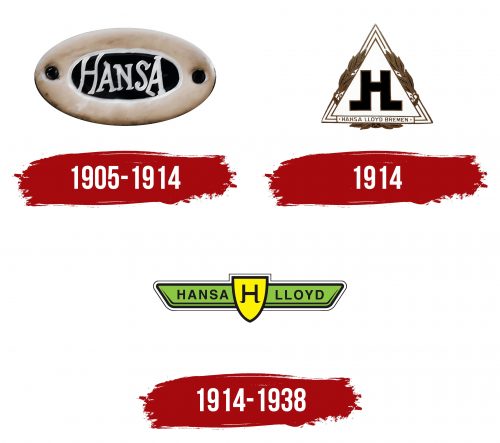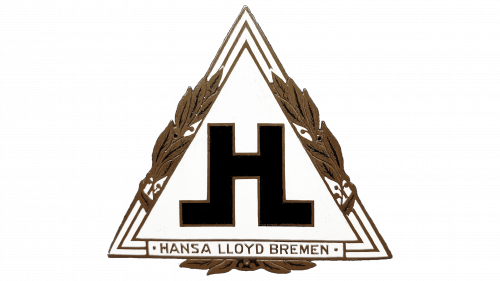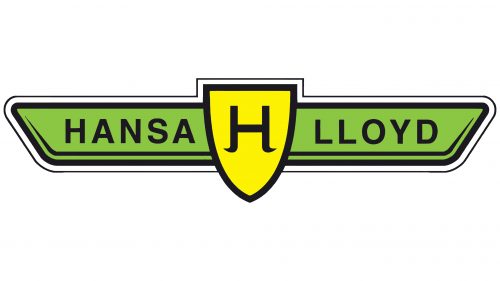The Hansa logo spreads its wings as if setting off for new shores. The emblem signifies the vast potential achieved by the two brands in tandem. The design exudes strength, freshness, and originality.
Hansa: Brand overview
The Hansa Company was founded in Bremen, Germany, in 1905. Initially named Hansa Automobilgesellschaft m.b.H., the company was established by local engineers and businessmen who recognized opportunities in the auto sector. The name “Hansa” was selected to pay homage to Bremen, one of the centers of the medieval Hanseatic League.
The first car was unveiled in 1906. It had a 28-horsepower 3.8-liter four-cylinder engine. Due to its excellent build quality and dependability, the automobile quickly gained a positive reputation among consumers.
During its initial years, the company concentrated on manufacturing luxury cars. The goal was to compete with well-known companies like Mercedes-Benz, which were independent companies at the time. The vehicles were known for their opulent interiors and cutting-edge, historically significant technology.
In 1914, the company underwent many developments. Like many other German automakers, it was forced to transition to making military hardware when World War I broke out. It produced trucks and other vehicles specifically for the army.
After the war’s end in 1918, the company encountered significant economic challenges. The German economic crisis and hyperinflation caused a significant drop in the market for luxury vehicles. In light of these circumstances, the business had to reconsider its approach.
In 1921, the company amalgamated with Lloyd, another automaker situated in Bremen. The new company’s name was Hansa-Lloyd-Werke A.G. This merger allowed the company to pool resources and technologies, which was essential given the difficult economic climate.
During the 1920s, the merged company underwent a period of diversification. It increased its output of trucks and commercial vehicles while starting to produce more reasonably priced automobile models. This tactic strengthened the company’s position in the market and allowed it to weather difficult times.
Another noteworthy event in the company’s history took place in 1929. Carl F. W. Borgward formed the automotive corporation Borgward, which bought Hansa-Lloyd. Borgward’s acquisition strategy aimed to establish a sizable automotive group.
Borgward kept using the brand for select car types after the takeover. The Hansa 1100 and Hansa 1700 were two of the popular models that were introduced in the 1930s. These vehicles had good technological specs and contemporary designs.
Once more, the Second World War caused production to shift in favor of military needs. The German army purchased military vehicles and parts from the plants, which were a part of the Borgward conglomerate.
Bombing seriously destroyed the company’s production facilities after the war ended in 1945. Restoring output took many years. While some Borgward car models continued to be sold under the Hansa name in the post-war era, their prominence gradually decreased.
During the 1950s, Borgward concentrated on growing its primary brand, and the moniker was used less frequently. Early in the 1960s, production came to an end.
The Borgward group filed for bankruptcy in 1961, along with all of its brands, including this one. In the eyes of the industry, this incident effectively signaled the brand’s demise.
Even though the brand was discontinued more than 50 years ago, its influence can still be seen in the development of German vehicle manufacturers. Collectors place a great value on these vehicles, and early examples are valuable displays in museums dedicated to the history of the automobile.
The evolution of the automobile sector in the first half of the 20th century was marked by technological advancements, mergers, and adaptability to shifting economic conditions, all of which are reflected in the company’s history. The company’s trajectory from luxury automobile producer to member of a major automotive conglomerate exemplifies the intricate and ever-changing history of the German automotive industry.
Meaning and History
What is Hansa?
This is a German automaker that specialized in creating mass-produced and inexpensive small cars. This brand was known for producing reliable and useful cars that were designed to meet the needs of ordinary people. The models’ simple but reliable design and efficient engines have made them popular among people looking for reliable transportation. The company was able to take its rightful place in the German automobile industry due to the fact that the cost was higher than luxury, and the cars were larger and more solid than their competitors.
1905 – 1914
Before merging with Lloyd Motoren Werke, Hansa adorned its cars with a stylish emblem shaped like a vertical ellipse. This plaque may seem outdated to modern car enthusiasts, but it heralded innovation and bold experiments with electric vehicles at the time.
Smooth curves create a sense of soft and swift driving, while the absence of corners hints at the vehicles’ complete safety. This symbolizes the promise of the new brand and its great ambitions.
At the center of the badge is the word “Hansa,” handwritten in white paint. The uneven font with curving strokes and large serifs evokes associations with The Addams Family media franchise. Of course, there is no connection; the whimsical lettering style simply reflects the early 20th century when bold fonts with various decorative embellishments were in vogue.
The company name is in a black ellipse, outlined with a white stripe. The emblem is placed within a wide beige frame that visually dominates the other elements. This large border might seem unnecessary, but it served a purpose: bolts were screwed into this section to attach the logo to the car without disrupting the integrity of the inscription.
1914
The Hansa company emblem, used from 1905 to 1914, features a triangle. The triangle’s points represent three key values: quality, comfort, and beauty. Lloyd Motoren Werke adopted this symbol after the companies merged, highlighting its historical significance and continuity.
A double frame around the triangle enhances its characteristics and adds significance. It symbolizes the unification of two brands into a joint enterprise, reflecting the company’s commitment to synergy and cooperation.
Laurel branches on each side of the triangle emphasize Hansa’s achievements and successes in the automotive industry. The central letter “H” stands confidently, symbolizing the company’s stability and reliability. The use of a single letter highlights Hansa’s foundation and leadership role.
The bottom of the emblem includes the full company name and its founding city, providing identification and historical context.
1914 – 1938
The emblem is shaped like an airplane, representing new opportunities and ambitious prospects for the brand in the post-war period. The green color emphasizes rebirth and growth, reflecting the company’s focus on renewal and progress.
A new model with an 8-cylinder engine was designed for fast and dynamic driving, similar to flying an airplane. This aspect highlights the company’s innovative approach to car manufacturing and its commitment to offering advanced technologies to its customers.
At the center of the emblem is a shield with the letter “H,” symbolizing reliability and tradition. This element reflects Hansa’s continuity and stability. The letter “H” stands for Hansa and its role in the automotive industry.
Robert Allmers, the company’s founder, leads the way and guides its development. His leadership and vision are crucial in shaping the company’s strategy and maintaining its traditions, making Hansa a respected and significant player in the market.







